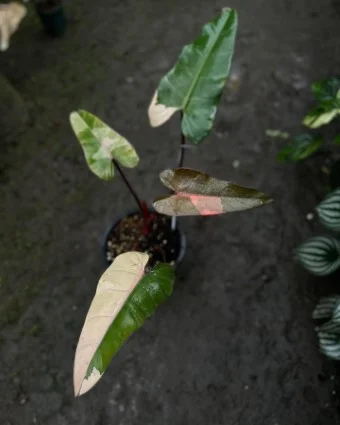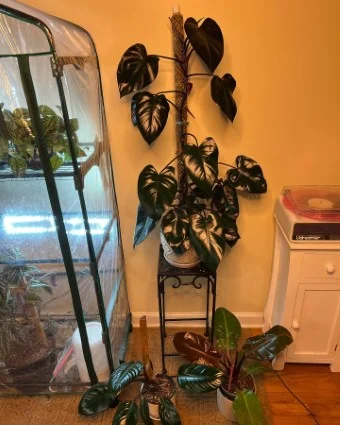Introduction
In the verdant depths of tropical rainforests, where the air whispers secrets of ancient times, a particular member of the Philodendron family has captured the hearts of houseplant enthusiasts worldwide – the Philodendron Dark Lord. It’s said that its leaves, which transition from a fiery orange to a deep, enigmatic burgundy, hold the mysteries of the forest within their folds, bridging the gap between the wild outdoors and indoor plant collections. I’m an avid plant lover, with years of nurturing various Philodendrons in my urban jungle, where the Dark Lord reigns supreme with its mesmerizing color palette.
The purpose of this post is to unveil the secrets to cultivating a thriving Philodendron Dark Lord, offering a comprehensive guide that covers every aspect of care. From ensuring the perfect balance of light and water to understanding its unique needs, we’ll explore how to foster growth and maintain the enigmatic beauty of this captivating plant.
Unveiling the Philodendron Dark Lord
Captivating Characteristics
The Philodendron Dark Lord is a spectacle of evolution, dazzling with leaves that narrate a color story from fiery orange to deep burgundy. This climbing vine, with its otherworldly foliage, not only graces spaces with its aesthetic appeal but also grows to a formidable size, potentially reaching up to several feet in height, given the right care and conditions.
Its growth habit allows it to be a versatile addition to the indoor garden, capable of being trained along trellises or allowed to cascade elegantly from hanging pots. The sheer size and dynamic coloration of its leaves make the Dark Lord a focal point in any interior setting, ensuring that it stands out as a pièce de résistance among house plants.
Beyond Beauty: Benefits
Aside from its captivating visual allure, the Philodendron Dark Lord contributes significantly to the indoor environment’s health. Like its Philodendron kin, it boasts air-purifying qualities, engaging in the subtle art of removing airborne toxins, thereby fostering a cleaner, fresher living space.
Furthermore, the presence of lush, vibrant foliage within the confines of the urban home serves as a natural stress reliever. Studies suggest that interaction with houseplants, including the mere act of caring for them, can reduce psychological stress, making the Philodendron Dark Lord not only a feast for the eyes but a balm for the soul.
Essential Elements Philodendron Dark Lord
Light Requirements
The Philodendron Dark Lord thrives in bright, indirect sunlight, a critical factor in maintaining its vibrant coloration and encouraging healthy growth. While it appreciates ample light, direct sunlight can be detrimental, causing the leaves to become scorched, which may lead to a loss of the plant’s characteristic deep hues.
In cases of light deficiency, symptoms such as leggy growth and pale leaves might emerge, signaling the need for a brighter spot. Ideally, position your Dark Lord near a window with filtered light to simulate the dappled sunlight of its natural habitat.
Watering Wisdom
A consistent “water when dry” approach is vital for the health of your Philodendron Dark Lord. Overwatering can lead to root rot, a common issue amongst houseplants, which is why assessing soil moisture before watering is crucial.
A simple finger test—inserting a finger into the soil up to the knuckle—can help determine when it’s time to water. If the soil feels dry at your fingertip, it’s time to hydrate. Allowing the top few inches of soil to dry out between waterings encourages a healthy root system.
Soil Secrets
A well-draining and aerated soil plays a pivotal role in the health of the Philodendron Dark Lord. Such a medium ensures excess water can escape, preventing the risks associated with waterlogging and root rot. A Philodendron-specific potting mix, often infused with perlite, orchid bark, and coco coir, offers an ideal structure. These components work together to retain enough moisture for the plant’s needs while allowing for adequate air flow around the roots, promoting robust growth.
Fertilizing for Flourishing
During the growing season (spring and summer), a balanced fertilizer can work wonders in supporting the Philodendron Dark Lord’s vigorous growth. A general guideline is to fertilize monthly with a half-strength dilution of a balanced, water-soluble fertilizer.
This regular feeding schedule helps to nourish the plant, ensuring it receives all the necessary nutrients for optimal growth and color development. Always follow the recommended dilution rates to avoid the risks of chemical burn to the roots, which can result from over-fertilization.
Philodendron Dark Lord Cultivating a Happy Climber


Providing Support
For climbing Philodendrons like the Dark Lord, investing in a moss pole or trellis is more than a practical necessity; it’s a ticket to witnessing this plant reach its majestic potential. These structures mimic the supportive trees and larger plants that Philodendrons would naturally ascend in the wild. Engaging with a moss pole or trellis, the Dark Lord not only showcases more vigorous growth but also develops larger, more robust leaves, as if reaching for the canopy’s dappled light.
Aerial roots, crucial for the plant’s nutrient uptake and stability, find a welcoming anchor in the moss, encouraging their growth and health. This symbiotic relationship between plant and support system enables the Philodendron Dark Lord to exhibit its full grandeur and vitality.
Humidity Haven
The Philodendron Dark Lord, akin to its rainforest predecessors, thrives in environments that emulate the warm and moist air of a tropical setting. A preference for moderate to high humidity makes this exotic beauty somewhat demanding, yet wholly rewarding. Creating a microclimate that caters to this need can be as simple as placing a pebble tray filled with water beneath the plant, using a humidifier to artificially raise the moisture level, or grouping plants together to create a communal transpiration system that benefits all.
These methods ensure the ambient air around your Philodendron Dark Lord is laden with moisture, promoting healthy leaf development, and preventing the tips from becoming brown and crispy. A humid haven is key to maintaining the lush, vibrant aesthetic that makes this plant a coveted treasure in home gardens.
Addressing Philodendron Dark Lord Dilemmas
Common Problems and Solutions
The Philodendron Dark Lord, despite its hardy nature, may encounter a few hurdles in its growth. Recognizing and addressing these issues early can ensure its continued health and beauty.
- Yellowing Leaves: Often a sign of overwatering, yellow leaves should prompt an immediate check of soil moisture levels. Ensure the pot has adequate drainage and allow the topsoil to dry out before watering again. Improving your watering regimen can quickly rectify this issue, promoting the return of lush, green foliage.
- Brown Spots (Sunburn): The appearance of crispy, brown spots on the leaves indicates that your plant has been exposed to too much direct sunlight. Relocate it to a spot where it will receive bright, indirect light. For leaves that are severely damaged, consider carefully trimming them to prevent further stress on the plant.
- Pests (Mealybugs, Scale): These pests can be effectively managed with a combination of physical removal and organic treatments. Wipe affected areas with a cotton swab dipped in rubbing alcohol to remove pests on sight. Neem oil, an organic insecticide, can be applied as a preventive measure to deter future infestations. Regularly inspecting your plant and maintaining a clean environment will help keep pests at bay.
When to Repot
It’s crucial to understand when and why to repot your Philodendron Dark Lord to ensure it continues to thrive. Signs that your plant is becoming rootbound include roots growing out of the drainage holes, slowed growth despite proper care, and water running straight through the pot. Generally, repotting every 1-2 years is recommended to provide fresh soil and more space for the expanding root system.
Spring is the ideal time for repotting, as the plant is entering its period of active growth and can recover more quickly from the stress of being moved. When repotting, choose a pot that is 2 inches larger in diameter than the current one to allow ample room for growth. Use fresh, well-draining soil and water thoroughly after repotting to help your Philodendron Dark Lord settle into its new home.
Philodendron Dark Lord Propagation Power
Unlocking the Potential: Propagation Through Stem Cuttings
Propagating the Philodendron Dark Lord through stem cuttings is a rewarding method that allows enthusiasts to multiply their beloved plants. Follow these step-by-step instructions to ensure successful propagation, nurturing new life from your existing plant.
- Select the Cutting: Identify a healthy stem on your Philodendron Dark Lord, ensuring it has at least 2-3 leaves and one node (the small bump on the stem from which leaves grow). This node is critical, as it’s where new roots will sprout.
- Make the Cut: Using a sterilized, sharp knife or pair of scissors, make a clean cut just below the node. A diagonal cut increases the surface area for root growth and helps in the absorption of water.
- Prepare the Cutting: Remove any leaves too close to the node to prevent rotting when planted. If your cutting has very large leaves, consider trimming them to reduce moisture loss through transpiration, which helps the cutting focus its energy on root development.
- Rooting the Cutting: You can root your cutting in water or directly in soil:
- Water rooting: Place your cutting in a glass of water, ensuring the node is submerged. Change the water every few days to keep it fresh. In 2-4 weeks, you should see roots beginning to form. Once roots have grown a few inches, the cutting is ready to be potted in soil.
- Soil rooting: Alternatively, you can plant your cutting directly into moist, well-draining soil. Make a small hole in the soil, insert the cutting ensuring the node is buried, and gently firm the soil around it. Keep the soil consistently moist but not waterlogged.
- Care After Propagation: Place your newly potted cutting in a location with bright, indirect light. Maintain high humidity around the plant by misting it regularly or using a pebble tray or a humidifier. In a few weeks, your cutting will start establishing itself, indicated by new growth.
- Patiently Wait and Monitor: Propagation is a game of patience. Keep monitoring your plant for growth and ensure it’s not exposed to direct sun, which can scorch its delicate leaves. Gradually, your propagation efforts will yield a new, thriving Philodendron Dark Lord.
By following these steps, you can expand your collection of Philodendron Dark Lord plants, sharing the joy and beauty of this stunning species with friends and fellow enthusiasts. Remember, the key to successful propagation lies in careful selection of the cutting, maintaining optimal rooting conditions, and patience as nature takes its course.
Conclusion
In summary, caring for your Philodendron Dark Lord requires attention to proper lighting, watering, and pest management, with occasional repotting and propagation to maintain and expand your collection. Remember, yellowing leaves may signal overwatering, brown spots indicate sunburn, and pests can be managed with routine care.
Repotting every 1-2 years and propagation through stem cuttings can rejuvenate and multiply your plants. We invite you to share your experiences and questions in the comments section below. Whether you’re troubleshooting an issue or celebrating a successful propagation, we’d love to hear about your Philodendron Dark Lord journey!
